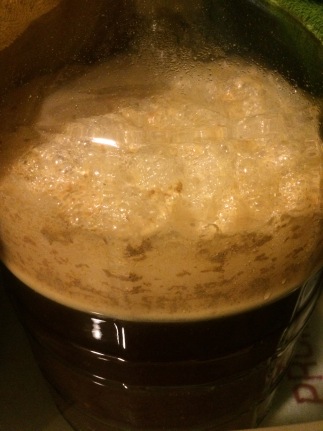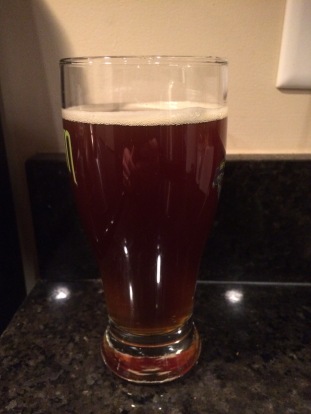This post is one in a series of making small adjustments to a single recipe in order to improve it, learn more about the impact each ingredient has on the finished product, and the art of recipe creation. The rest of the series can be found here.
Brew Day
I recently began working for a company that observes all the federal holidays—even the ones schools don’t get off. This means that another seemingly random Monday holiday showed up on my calendar, and so, not knowing what else to do with myself, I decided to take proper advantage of it and brew.
All in all, this was perhaps the most uneventful brew day I’ve ever had (in a good way). I started early, so I replaced my standard brew-day beers with mugs of coffee. Everything went smoothly: I hit my target mash temperature; I didn’t have any boil-overs (which is a constant concern for me due to the size of my kettle); and I even shaved some time off my process. The latter was done by switching from fly to batch sparging. After some reading and hearing some of the equipment considerations for determining which method would be best practice, I figured I’d give it a shot. Not only did it save me time, but my efficiency actually improved by 5%. This means that my OG actually matched the original recipe for this brew, so I would call that a double win.
The only thing that threw me off was the fact that I decided to heat my strike water in my kettle due to the volume initially needed. I do have a pot I usually use as an HLT, but it’s smaller, and the amount of water I needed for my second sparge—well, in retrospect, it would have fit. The point is that I began heating my sparge water in my kettle too, not thinking that I needed my kettle to collect my first runnings. Long story short, I had to collect my first runnings in my HLT and then juggle my wort and some other pre-gathered water between containers. It certainly wasn’t the worst thing that could have happened, but this was a new process for me, and now I know for next time.
After all was said and done, I collected my wort, let it settle into fermentation temperature, and pitched my yeast. Within five hours, I already had signs of active fermentation.

Recipe
Of the goals I had set for this iteration, the main focus was to achieve a richer flavor of dark fruit from the malt. Having used crystal 80 in my last brew, I determined that this didn’t give me enough of the flavor I was looking for and that even adding more C80 wouldn’t get me where I wanted to be. I had a few questions after tasting my last brew:
- What grain do I replace the C80 with?
- Regarding the grain I replace it with, should I increase the percentage in the grist?
- Should I not replace the C80 and simply add to it?
- If I add to it, do I keep the same percentage of C80 or do I lower it?
I began by thinking through the question of adding to the C80. As I’ve continued to drink through Iteration 1, I’ve decided that the flavor of C80 was just not what I was looking for at all. It felt too light with what might be a toffee flavor. Although I love toffee and would enjoy this flavor if it were my end goal, it simply wasn’t the taste I was going for with this brew. If I eventually decide that I want more of that lighter caramel flavor in addition to that as-of-yet elusive dark fruit flavor, I believe a lighter crystal malt would be a better option than keeping the C80 and adding to it. Answering this question also resulted in the fourth question above becoming irrelevant.
The next question I tackled was that of the replacement grain’s grist percentage. There were a few possibilities to consider here. First, because the C80 didn’t pack as much malt character as I wanted, I had to consider that it was possible that the amount also affected this somewhat lackluster flavor. The alternative I had to consider, though, was that perhaps increasing the percentage in addition to changing the grain would yield a fuller maltiness than I desired. Therefore, I decided to do a strict replacement of C80 for this iteration. The primary reason for this was to limit variables and give as direct of a comparison as possible between the flavors of the C80 and what I chose to replace it with. This left the final decision to be the grain choice itself.
I’ve been given many suggestions on grains, including Crystal 120, Special B, and CaraAroma. All of these are purported to yield the dark fruit flavor that I’m looking for, so maltster descriptions didn’t get me very far in making this choice. The deciding factor between these grains ended up being the recipe of another beer that I know has an incredibly deep cherry/plum flavor from the malt. That particular recipe uses C120, so I decided to trust the flavors of something I know I’ve tasted before and hope that it turns out the same way for me.
- Mashed at 150⁰ F for 1.25 hrs.
- 10.25 lbs. 2-Row
- 1 lb. Crystal 120
- Boiled for 1 hr.
- 0.5 oz. Simcoe (60 min) at 12.2% AA
- 0.5 oz. Simcoe (30 min) at 12.2% AA
- 0.5 oz. Cascade (15 min) at 5.0% AA
- 0.5 oz. Centennial (5 min) at 9.7% AA
- Pitched US-O5
- OG: 1.064
- FG: 1.010
- ABV: 7.1%
- Dry hopped 0.5 oz. Cascade and 0.5 oz. Centennial for 5 days.
- Bottled and primed with 4 oz. of priming sugar.
Tasting
The color of this beer is closer to the red hue I hope to achieve; however, it’s still more dark amber than it is red. But, as the color is less important to me than the flavor, I’ll move forward.
The aroma holds a citrus nose. More surprising to me, though, is how strong the malt character came through here. There is a definite plum scent, which is pleasant and boded well for this iteration. A hint of tart cherry was also present, if slightly.

The flavor has a strong raisin flavor mixed with plum. As the beer warms, though, the raisin flavor fades and melds into a stronger plum flavor. The finish is bitter, but there is not much hop presence to speak of, save a slight floral note and, as it warms, some citrus. The alcohol presence is somewhat heavy—much more so than I expected it to be. Unfortunately, that isn’t a great thing for this beer as it stands right now. The alcohol flavor is too prominent is the absence of other flavors to balance and complement it.
Goals for the Next Brew
There was one thing that I overlooked in my excitement about my increased efficiency allowing me to hit the OG of my original version of this recipe: BU:GU ratio. While the hop presence of Iteration 1 wasn’t as intense as I would have liked it, this version is less so due to the increased gravity without compensating with additional hops. For some reason, this didn’t even occur to me until I tasted it. So, a new goal for hop character (in addition to those already decided by Iteration 1) is to find a more appropriate and hop forward BU:GU ratio. I think this will land me at a ratio of 1:1 or higher. That said, it’s worth repeating that I plan to begin changing the hops in this recipe only after I have the malt profile where I want it.
I also want to find a way to maintain this ABV, but balance it more. The booziness is prominent because there is some level of complexity missing. I am unsure at the moment if that is due to using less hops than this recipe truly needs or if it’s because of a lack of malt complexity. Even if the alcohol could be best complemented by a livelier hop presence, I think the malt bill also needs some more character to it than the C120 alone. It has yielded the plum flavor I wanted, but it needs something else.
The questions I will try to answer for next time are:
- What malt do I add to the grain bill?
- Should I keep the percentage of C120 the same?
